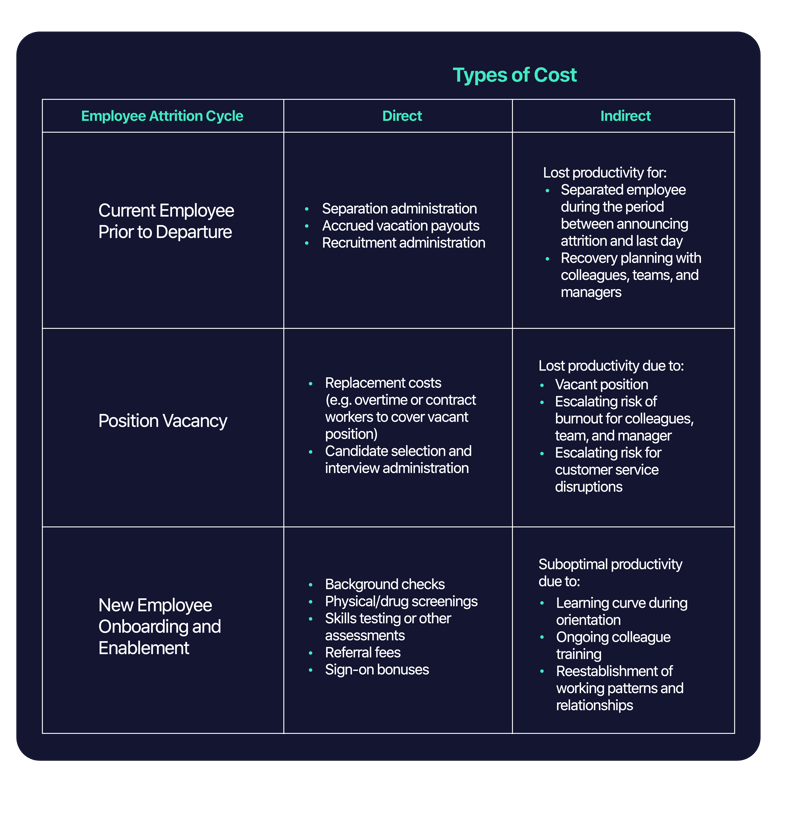Employee turnover is expensive. The Society for Human Resource Management (SHRM) reported in April 2022 that the total cost to hire a new employee can be three to four times the position's salary.
Sound too high? Just considering direct costs, you’d be right. The direct cost of replacing an employee may amount to only a third of a position’s salary. But how do we account for the indirect costs? Cost calculations are a tricky business. However, this accounting not only helps with budgeting; it can also tell us a lot about the kind of organization we work for.
Identifying Direct and Indirect Costs
No matter your organization type or line of business, cost-of-turnover calculations are complicated.
Voluntary attrition is qualitatively and quantitatively different from involuntary turnover. A quit, a termination, and a retirement all have different cost implications.
Every task associated with attraction, recruitment, selection, and onboarding costs money. Trained staff dedicate their time to each stage of the process. Each stage uses licensed software. HR, manager, and supervisor duties expand to include screening, interviewing, and training. IT sets up email and protects it from malware. The list goes on. These are all direct, fixed costs.
Though there are many, direct costs are relatively easy to count. That’s why there are so many cost-of-turnover spreadsheets online readily available for download. They list all the costs associated with filling positions. To calculate your cost, just plug in your line items, add them up, and multiply by your turnover rate.
There’s a problem, though. On the balance sheet, when someone quits, the cost of their employment drops to zero. If that position was budgeted through the fiscal year, an organization makes money for every pay period a position remains vacant. In fact, if everyone quit at once, there would be a windfall! Obviously, this view is myopic. A direct-cost focus without considering indirect costs leads to strange conclusions.
Replacing People is Not the Same as Filling Positions
The reason the math doesn’t work is because when a person quits, two things happen at once. A position is vacated and, more importantly, a person leaves. Writing in Forbes, Melanie Fellay puts it succinctly: “The departure of great people can have a major influence on team morale and places an unnecessary burden on the remaining employees who acquire the extra workload.”
Attrition’s direct costs are closely associated with filling positions. Indirect costs relate to lost employee expertise, interrupted customer relationships, and impact to former colleague engagement and productivity.
One key lesson of the Great Resignation reported by countless organizations is that turnover seemed to spread through their employee populations. Put simply, turnover is contagious. The impact of turnover on morale and subsequent productivity adds up fast. That is, for each voluntary termination, and the ensuing disengagement that accompanied it, there was an escalating risk for even more.
Speaking of risk, according to some studies, nearly 70% of organizations surveyed have suffered a loss of data, knowledge, or intellectual property as a result of turnover. In other words, people who quit take sensitive data with them as they leave. The direct costs associated with data breaches are difficult to estimate, but they pale in comparison to the indirect costs to brand integrity and credibility.
The investment in employees lost to attrition is also hard to estimate. Employees tend to become more valuable with each passing day they’re employed. It’s one primary reason for asking for and receiving a raise. Salary, benefits, bonuses, and training that accrue to a person during their tenure represents a large financial outlay.
Organizations exchange performance for salary, so each paycheck represents a literal investment in the employee receiving payment. The payoff is an employee whose expanded knowledge, skillset, and stature will increasingly play impactful roles in an organization’s future. "These are the people who have so much tribal knowledge and are so valuable that they become almost irreplaceable," writes the Harvard Business Review. When a person quits, it’s as though they sell their stock. Organizations might break-even on a cost-to-performance basis, but the value of their investment drops to zero. What’s more is that employees bring those long-hoped-for dividends to their new roles, often working for direct competitors.
Cost in the Context of the Attrition Cycle
Consider this table of high-level costs accrued to an organization during the attrition cycle. In actuality, direct and indirect costs are far more numerous than what’s presented here.
For example, employee attrition among remote employees now incurs costs like shipping charges to reclaim computer hardware or office furniture. Sourcing new employees across the ever expanding social media landscape is becoming more expensive and harder to achieve. Onboarding can take anywhere from 60 days to six months. More sensitive cost calculations account for gradual increases in new employee productivity, but the full list of these expenditures is beyond the scope of this piece.
How Strategic Employee Listening Can Reduce Attrition Costs
The best way to reduce the cost of employee turnover is to prevent it. A regular, thoughtful cadence of listening, with a commitment to act on the captured employee insights, can help your organization detect early warning signs of attrition. Here are some strategies to consider.
- Monitor changes to your culture. When employees quit, find out why. People are only attracted to different organizations because they believe they’ll have a better experience somewhere else. Something is missing in their professional life, and they’re willing to take a chance somewhere new and largely unknown to find out what it is.
- Annual surveys that benchmark cultural development are necessary, but not enough. Once-a-year annual surveys are a good start in the battle against attrition. They’re great for helping to identify systemic issues in an organization’s culture and holding leaders to account for action and change-management. Given the velocity of change in the labor markets and society in general, they’re simply not enough. Continuous listening surveys provide actionable feedback that help leaders see problems and activate responses before the problems spin out of control.
- Analytically model employee turnover. Become conversant in what variables influence turnover. Machine learning (ML) can make accurate predictions about the kind of people who are likely to quit. Locating hot-spots in your organization can spur proactive recruiting and risk mitigation. It can also lead to the discovery of winning retention strategies and the implementation of best practices.
- Believing an employee might be at risk for attrition gets you halfway there. No statistical analysis or cost accounting will help you to actually intervene. An ongoing dialogue with your workforce can help you cultivate the kind of relationship that makes people attrition-proof. Stay interviews will help you understand why people in mission-critical roles and departments have remained with the company.
Perceptyx Can Help You See More, and Do More, About Employee Turnover
Establishing the proper context for conversations about turnover matters, as does having the correct data at your fingertips to calculate turnover’s direct and indirect costs. As an experienced listening partner, Perceptyx can help your organization conduct all the meaningful conversations needed to fully and comprehensively understand employee attrition and retention. To learn more about how we can help, schedule a meeting with a team member.
